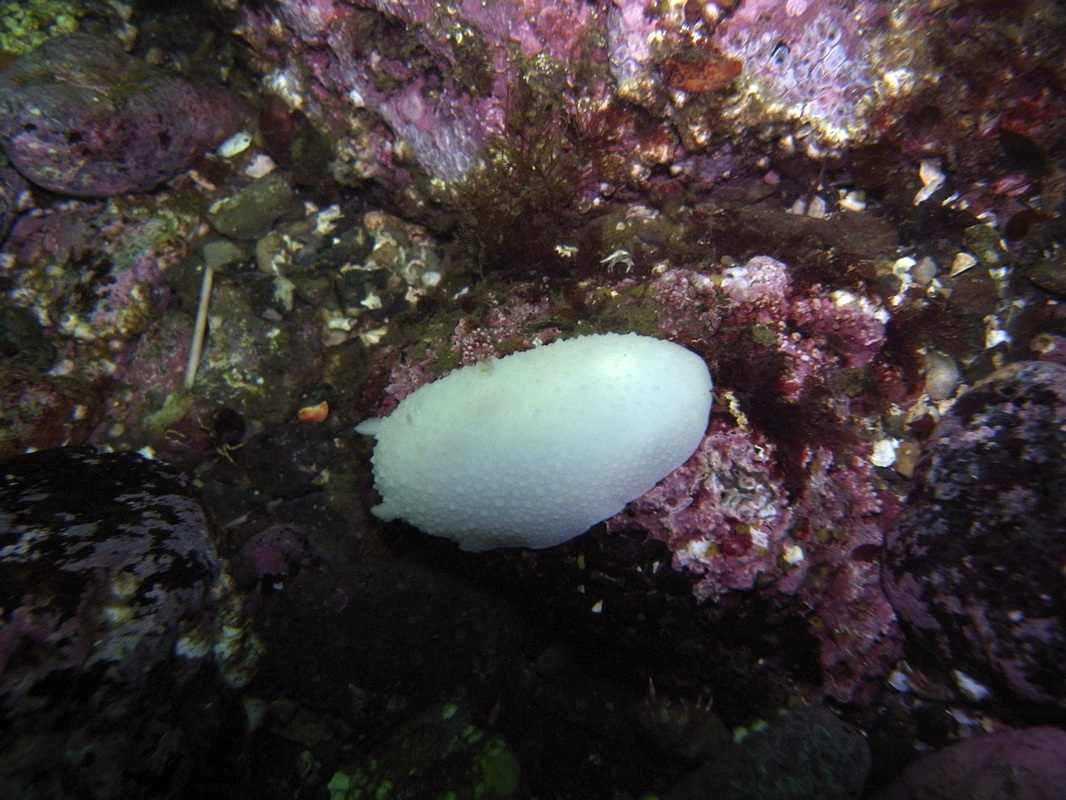Giant white dorid, white nudibranch, white knight dorid, Odhner's dorid • Doris odhneri, Archidoris odhneri
{odhneri = for Swedish zoologist Nils Odhner}
Identification
The giant white dorid, usually bright, pure white, occasionally has a yellowish tinge. Like other dorids it has an oval body shape and a retractable gill plume at its posterior end. This plume is circular and flower-like. The rhinophores look like small white horns. The dorsal side of the body is covered in small tubercles, giving it a roughened appearance. While most individuals of this species are around 6-9 cm long, 20 cm-long individuals have been recorded. Click here for more photos.
Habitat & Range
The giant white dorid lives in rocky areas where sponges are plentiful. It is mostly found in the subtidal to a depth of 50 m, and is less common in the low intertidal. Its range extends from northern Alaska to southern California.
Similar Species
The Monterey sea lemon (Doris montereyensis) and the Pacific sea lemon (Montereina nobilis) are similar in shape but not in colour: both are yellow to orange and marked with dark spots.
Intriguing Info
This nudibranch eats sponges such as the bread crumb sponge (Halichondria bowerbankia). It is preyed upon by the rose star (Crossaster papposus)
iNaturalist
https://www.inaturalist.org/taxa/124210-Doris-odhneri
The giant white dorid, usually bright, pure white, occasionally has a yellowish tinge. Like other dorids it has an oval body shape and a retractable gill plume at its posterior end. This plume is circular and flower-like. The rhinophores look like small white horns. The dorsal side of the body is covered in small tubercles, giving it a roughened appearance. While most individuals of this species are around 6-9 cm long, 20 cm-long individuals have been recorded. Click here for more photos.
Habitat & Range
The giant white dorid lives in rocky areas where sponges are plentiful. It is mostly found in the subtidal to a depth of 50 m, and is less common in the low intertidal. Its range extends from northern Alaska to southern California.
Similar Species
The Monterey sea lemon (Doris montereyensis) and the Pacific sea lemon (Montereina nobilis) are similar in shape but not in colour: both are yellow to orange and marked with dark spots.
Intriguing Info
This nudibranch eats sponges such as the bread crumb sponge (Halichondria bowerbankia). It is preyed upon by the rose star (Crossaster papposus)
iNaturalist
https://www.inaturalist.org/taxa/124210-Doris-odhneri
References
Harbo, R. M. (2011). Whelks to whales: Coastal marine life of the Pacific Northwest [revised]. Madeira Park, BC: Harbour Publishing. P. 150.
Lamb, A., and Hanby, B. (2005). Marine Life of the Pacific Northwest [electronic version]. Madeira Park, BC: Harbour Publishing.
Wheeling, R., Helmstetler, H., and Cowles, D. (2005). Doris odhneri (MacFarland, 1966). Invertebrates of the Salish Sea. Rosario Beach Marine Laboratory. Accessed 16/02/2015.
Authors and editors of page
Kelly Fretwell and Brian Starzomski (2015).
Harbo, R. M. (2011). Whelks to whales: Coastal marine life of the Pacific Northwest [revised]. Madeira Park, BC: Harbour Publishing. P. 150.
Lamb, A., and Hanby, B. (2005). Marine Life of the Pacific Northwest [electronic version]. Madeira Park, BC: Harbour Publishing.
Wheeling, R., Helmstetler, H., and Cowles, D. (2005). Doris odhneri (MacFarland, 1966). Invertebrates of the Salish Sea. Rosario Beach Marine Laboratory. Accessed 16/02/2015.
Authors and editors of page
Kelly Fretwell and Brian Starzomski (2015).





